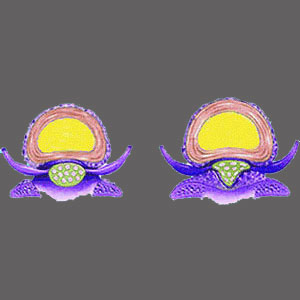
Spinal stenosis osteophytes can be causative or contributory issues in central canal and foraminal narrowing conditions throughout the human spine. Osteophytes, also called bone spurs, are a result of the arthritic processes and are common to experience as we age. Osteophytes can form on many bones and joints throughout the anatomy, and the spine is certainly no exception. While osteophytes are indeed typical parts of getting older, and are usually nothing to worry about, there are some cases where they can become extremely problematic, depending on where they grow. When an osteophyte forms inside the central spinal canal or in a neuroforaminal space, a stenosis condition can develop, potentially leading to a dire symptomatic expression.
This discussion explains how bone spurs can cause or contribute to stenos blockages in the central spinal canal, as well as within the neuroforaminal openings.
What are Spinal Stenosis Osteophytes?
Osteophytes are small growths of bone or calcified soft tissue which have a tendency to form in many places on or in the spinal column. Most bone spurs are the result of osteoarthritic change which occurs due to wear and tear on the spinal joints, including the loss of protective cartilage, the decrease in synovial fluid and the incidence of bone-on-bone contact related to the above scenarios.
Degenerative disc disease is not part of the arthritic process, but it is also a contributor to bone spur formation, since vertebrae get closer together and have more incidental contact as the discs thin out.
Bone spurs are usually small and not notable individually, although large ones or numerous ones in a particular area may be cause for alarm in some patients.
Arthritic Osteophyte Facts
Osteophytes implicated in narrowing the central canal or foraminal spaces can not usually be treated effectively through any means except spinal stenosis surgery. Conservative care simply will do nothing to reduce arthritic build-up of bone spurs. Luckily, most bone spurs are nothing to fear and while they reduce the patency of the central canal or neuroforamen to some degree, it is rare for a single or even multiple small osteophytes to actually elicit a true spinal stenosis condition.
Large osteophytes, or a concentrated number of osteophytes, can certainly cause spinal stenosis and can also cause foraminal stenosis. This is particularly true when other contributory factors exist at the same level, such as herniated discs or abnormal spinal curvature issues.
Prognosis for Spinal Stenosis Osteophytes
Many MRI reports list osteophytes as reducing the size of the foraminal space or limiting the size of the central canal. Only the largest or most numerous osteophyte conditions are likely to be problematic unto themselves, but with other spinal issues in the same region, spinal stenosis is the likely result.
We see many examples of osteophytes which form in combination with herniations, often acting together to form osteochondral bars. These can be a problem when they are large and can be even worse when they exist with similar posterior canal conditions, such as ligamentum flavum hypertrophy. Remember that most spinal arthritic processes may contribute to or directly source minor stenosis issues, but these are usually not symptomatic in the majority of patients. Particularly large or numerous bone spurs, as well as associated spinal canal debris, especially in the elderly, are one of the main sources of symptomatic stenosis and may require invasive surgical therapy.
Spinal Stenosis > Causes of Spinal Stenosis > Spinal Stenosis Osteophytes





